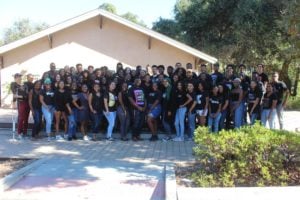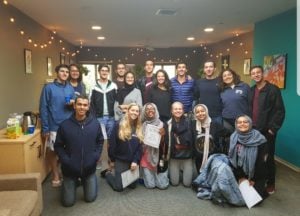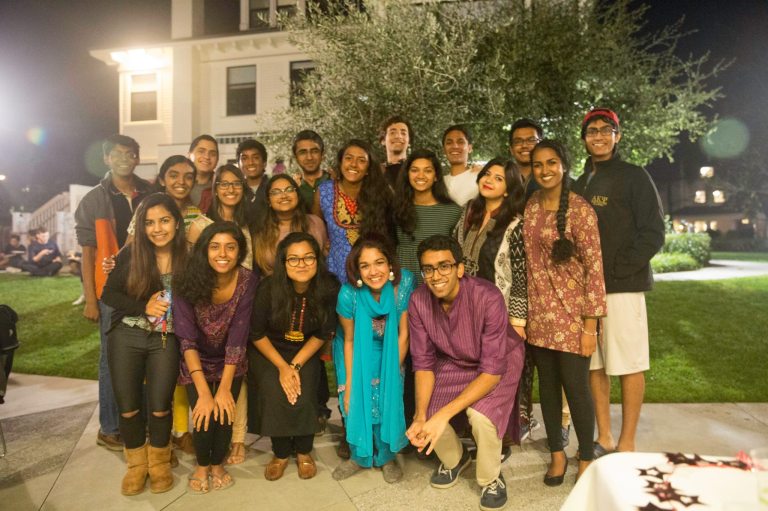ASAS. PASU. MEChA. BSU. Q&A.
Like most things at Stanford, ethnic and cultural organizations constitute an array of acronyms. This speaks to the sheer number of groups on campus built around ethnicity and its intersections with sex, race and politics. Nonetheless, most members of these organizations identify with not just the organization’s literal title but also the group’s sense of community or outreach efforts. In fact, some members identify with everything but the title: These are students who join ethnic organizations not of their ethnicity.
A search for broader community and cultural understanding
Katie Jonsson ’21, who identifies as white and not Arab, is a member of the Arab Student Association at Stanford (ASAS). Having spent the last four years at a boarding school in Jordan, she considers herself part of a subset of ASAS members “who have no ethnic connection to the Middle East but have a strong emotional connection to it.”
Jonsson has always been interested in the Middle East, so after hearing about her older sister’s positive experiences in ASAS, she joined the organization in the hopes of finding “a sense of community” as she began her career at Stanford. A potential International Relations major, she believed that ASAS would allow her to thoughtfully explore and educate herself about the Arab world.
Similarly, Michelle Bae ’20 views ethnic organizations as a means of learning more about the cultures of the world, as well as cultivating community. A Korean American, Bae joined the Pilipino-American Student Union (PASU) last year because “it seemed like a good family.” This year, she also joined Sanskriti, an undergraduate South Asian organization, at the recommendation of a friend and to learn about South Asian culture.
Bae wants to learn about unfamiliar cultures through ethnic organizations, in particular, because she believes they are immersive and respectful educational platforms.
“It’s valuable to put yourself into a new community to learn,” she explained. “I honestly feel like sticking yourself in that culture is the best way to do it because it seems like so non-intrusive. Just like you go to meetings, you’re legitimately putting in the time… I’m not enjoying the culture or benefiting from the culture without getting to know the people because that would be awful… It comes with the nuance of people when you join the group.”
She also joined Sanskriti to address a gap in her experiences with the Asian-American/Pacific Islander (AAPI) community at-large, which she was already engaging in as a member of Queer & Asian and Sigma Psi Zeta and as a resident of Okada, the Asian-American ethnic theme house.
“Many of my other ethnic organizations don’t really have South Asians as part of them even though they’re all AAPI organizations, which is kind of awkward because … so often [the AAPI community] is painted as a monolith,” Bae said.
Like Bae, Rogelio Salinas ’20, who identifies as Latinx but not black, cites a desire to foster connections between ethnic organizations as his reason for serving as a staffer at the Black House. Last year, he was a member of the Black Student Union (BSU) and Stanford’s NAACP chapter, and he also lived in Ujamaa, the black ethnic theme house. He also works with the Latinx community on campus through Movimiento Estudiantil Chicanx de Aztlán (M.E.Ch.A) and Los Hermanos de Stanford.

Having attended a high school where his peers were largely black and Latinx, Salinas wants to further unify the two ethnic communities at Stanford because they “aren’t as close as they were back home,” and he believes members of both groups would enjoy and benefit from interethnic interaction. In particular, he hopes linking the two ethnic communities will allow them to work together to combat shared social issues.
“If students want to make change on this campus, particularly with protests and activism, [and] if we’re all in 50 different organizations, it’s hard for us to congregate together to work on the same things that we all definitely care about,” Salinas said, citing the example of prison reform as one such issue.
As a bridge between the black and Latinx communities, Salinas wants to facilitate interethnic collaboration for the greater good.
Finding belonging
Bae, Salinas and Jonsson’s motivations for joining ethnic organizations not of their ethnicities are each highly personal but present some parallels. Likewise, their experiences in these organizations have been necessarily different but comparable in their generally positive nature.
Bae described her experiences in Sanskriti as “really good so far” but noted that “sometimes there’s definitely a ‘Whoa, this is kind of like a learning curve’ [feeling].”
Sometimes she does not understand non-English phrases or pop culture references used by South Asian members and has to ask someone to translate or explain.
Rather than being disheartened by such experiences, however, Bae considers moments of disorientation and the subsequent explanations “super important because it’s not me looking up a Wikipedia article and seeing the abridged version of this people’s history. It’s me going in — in I feel a mostly non-intrusive manner because I’m learning with the people, rather than about the people.”
Just as Bae sees merit in exposure to the unfamiliar, she is excited when conversations in PASU and Sanskriti delve into themes that resonate with her Korean-American identity, like food, family and colorism in the AAPI community.
“It’s really nice to share these experiences and come together in allyship,” Bae said. “I find it very …enlightening.”
Jonsson, likewise, speaks fondly of being able to bond with fellow ASAS members over shared experiences.
She feels that “there is a lot [she] can identify with” when conversation turns to Arab culture. “There are definitely times when they’ve in ASAS mentioned a movie or a dish, and I know how to make it, or I’ve made it with my friends.”
“I do feel a strong community,” she contended.
Besides allowing her to meet like-minded students, both fellow freshmen and upperclassmen, Jonsson appreciates how ASAS connects her to the Arab world at large, beyond the Stanford bubble, citing how the group recently organized a trip to San Francisco, where members met with local Arab entrepreneurs.
“The Arab SS and a lot of ethnic groups are incredibly inclusive and … it generally comes down to whether you have a genuine interest in that culture,” Jonsson said. “Ultimately any perceived boundaries in race, culture, background or ethnicity, I think, will fade away when two people are interested in the same thing.”
Similarly, Salinas has found the black community “very accepting of other ethnicities and races of people” and described his experiences within it as “some of the best I’ve had at Stanford for sure.”
Dealing with initial hesitation to join
While Salinas and Jonsson have enjoyed being in ethnic organizations not of their ethnicity, they acknowledge how their unique contexts eased their integration into these groups, perhaps differentiating them from the average interested student.
Having lived in Ujamaa during his freshman year, Salinas’ fellow residents were vital sources of information and encouragement when he began to engage with Stanford’s black community.
“I lived in Uj and with people who were tied very directly to the organizations [I joined]. I think that’s definitely helpful with outreach,” he added. “I mean I definitely heard most about the black community through people I knew. I think it’s definitely hard to enter communities if you don’t already know people in it.”
Jonsson voiced a similar view about why some students might hesitate to join outside ethnic organizations.
“Coming as a non-Arab and wanting to be a part of the ASAS community, I felt like the reason I was accepted is because I have a strong tie to the Middle East, and I had spent four years there,” Jonsson said. “However ,I think if I hadn’t had that exposure to the Middle East, it would have been quite daunting [to join ASAS], especially if it’s just an area of the world you’re interested in.”
She attributes this hesitation, in part, to the way many students understand the purpose of ethnic organizations.
“I think a lot of these ethnic groups are seen as, ‘oh, the Filipino Association is for Filipino students to get to know each other, rather than … a chance for other students to get to know the Filipino world,’” Jonsson explained.
She believes that emphasizing ethnicity over culture and the organizations’ internal development over outreach might make students reluctant to engage with these groups as they worry about feeling disoriented or infringing on a safe space.
The role of the external gaze
Some interviewees felt that uncertainty about participating in ethnic organizations not of one’s ethnicity can be linked to harsh external scrutiny.

“I have the ASAS rollout poster on my door, and people will walk by and be like, ‘You’re not part of ASAS — you’re not Arab,’” said Jonsson. “So I feel often I have to like justify being in ASAS, not even to members of ASAS, but to the outside community… I grew up in Jordan. It’s a huge part of who I was. But if I was just really interested in the Middle East and the Arab world, and I didn’t have that justifier, I think it’d be really hard. And ultimately the Middle East is something I’ve been interested in my whole life, and even if I hadn’t lived in Jordan, I would still want to be part of this club, but I wouldn’t know how to explain to people why.”
Brent Obleton, Interim Director and Dean of Students of the Black Community Services Center (BCSC), echoed Jonsson’s observations:
“Whenever [students] feel like that sense of belonging is being infringed upon, whether it be by people talking about them — not only comments but also how people look at them — [that] plays a role in them being hesitant to join these organizations.”
Cindy Ng, Director and Associate Dean of Students of the Asian American Activities Center, pointed out an interesting catch-22 in how the external gaze has a “tendency to see ethnic groups as self-segregating” yet, simultaneously, can discourage students from attempting to join ethnic organizations outside their ethnicity.
Jonsson and Salinas both hope their work with outside ethnic organizations will help other non-Arab or non-black students, respectively, who are keen on joining these communities, distill their own convictions from the self-consciousness outside scrutiny can inspire.
“For me, if I want to get more Latinx people to come to the Black House and interact with the black communities, I think saying ‘I’ll be here, you should come by’ or something like that … makes that situation easier,” Salinas said.
All the same, Bae, Salinas and Jonsson agree that, while they have enjoyed being in other ethnic organizations, it is not necessary that all students try to do the same.
“For a lot of people, it just doesn’t make sense for them to join an ethnic group that they don’t consider themselves part of,” Bae stated, reiterating that reasons for joining these groups are and should be highly individualized, given the personal nature of ethnic identity. In fact, all three students noted that joining and staying in ethnic organizations not of their ethnicity has, with good reason, required a lot of internal reflection on their behalf.
A need for self-awareness
“I need to remember that I enjoy a privilege in being able to join these different groups,” Bae stated, “so I need to be aware that I’m not exoticizing other cultures because I joined these groups to learn about culture respectfully … but there can be a fine line between cultural appreciation and appropriation.”
Jonsson, meanwhile, noted students of other ethnicities “who join these clubs have to be very internally aware of why they’re doing these things and whether it’s a genuine effort to be part of this community or whether it’s overshadowing the space of someone else.”
From personal experience, she contended, “I feel like a lot of times, coming from the Middle East and maybe being a non-Arab member of an Arab community … people ask me, ‘How do you feel about the Trump ban or Robert Spencer?’ And part of me wants to say, ‘It doesn’t matter what I feel. I’m not the one being affected.’”
While such issues are important to her, she wants to reserve space for Arab and Muslim students who are directly impacted by these topics.
Obleton affirmed: “Coming in there to not take up space is definitely a thing, and allowing those who do identify to take up that space and to reside in that space and not infringe in those intimate conversations where [we say], ‘Look, this is a very real thing, something you can’t identify with, but we still welcome you into this space.’”
Salinas and Jonsson both noted a belief that the best thing they can do as members of ethnic organizations not of their ethnicity is to help create space for other members to speak about the issues they face, rather than speak for them.
“It’s more like I’m here to help facilitate what students want and what students need here in the black community,” Salinas explained, “but not to sort of be the face of the Black House or to want to change the way black students act at Stanford or something like that.”
He believes that “those are very important distinctions to make for doing that — [for] working in different communities than the ones you may identify with.”
Embodying a vision
According to Ng, ethnic organizations “provide students with environments where their shared culture, backgrounds, experiences and identity are validated and valued. Ethnic organizations also collaborate and provide opportunities for meaningful cross-cultural dialogue and engagement across campus.”
In many ways, this definition rings true for Bae, Salinas and Jonsson, albeit in a somewhat untraditional way.
Contact Megha Parwani at mparwani ‘at’ stanford.edu.
